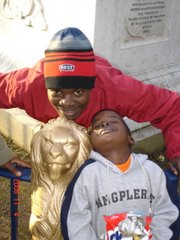We are all fascinated by the jaw morphology adaptation of Lake Malawi cichlids as one of the driving mechanism in their diversity. One of this months published studies has revealed the lateral line to be among the wonders of the feeding behaviour in cichlids.
Working on one of the peacock cichlids of the so called "Alunocara" group, it has been reported that their wide cavity lateral line is responsible for the efficiency of this species in getting food.
Three groups of fish were studied, one with normal cavity, another chemically deformed and last group feeding in the dark. The chemically deformed lateral line failed to ge their prey, while the other two hand their game on spot.
Let us know that this mechanism is widely spread among the deep sea fish, and for the peacocks to posses this adaptation within Lake Malawi system which is suggested to have clear waters and suppossedly clear feeding vision is one of the seven wonders in fish biology and the cichlid system as a whole.
As if this is not enough, on a lighter note this group of "Alunocara" is among the most expensive products of the aquarium trade despite having a wide distribution range within Lake Malawi.
The Lake Malawi biodiversity will never cease to amaze us!
WHATS NEXT THE CICHLIDS WE ARE WATCHING.
Monday, June 22, 2009
Friday, June 19, 2009
Hatchery breeding for reintroduction into Lake Malawi
Evidence is increasing on the downside of captive breeding aimed for reintroduction into the wild. A study published in Biology Letters suggest that wild born offspring from hatchery raised Steelhead Trout parents has only 37% reproductive fitness as compared to 87% if only one of the parents was wild breed. These differences are still detected even if the fish have spent one generation in the wild.
Lake Malawi holds one of the stunning cichlid biodiversity in the world, however this biodiversity is believed to be only 1 to 2 million years old. In other words is still going through sysnthesis, thus most of the cichlids still interbreed naturally during a secondary contact. The results from the above mentioned study should tell us that one of our cards to mitigate for overfishing of the most sort Tilapia should not be hatchery raised ones, but reinforcement of the fishing season and fishing gear size.
If hatchery breed fingerlings are to be used in Chambo restoration plan, then genetic differences between them and wild types should be well studied. As far as I know the aquaculture stock at the moment may not be the best candidates for this exercise. Molecular studies have already revealed that the aqua stock has a mixed up gene pool, that is neither pure Chambo (O. karongae), nor Makakana (O. mossambicus) to mention a few.
All the evidence points us to one thing, Chambo restoration plan should be based on proper scientifc evidence not emotions or personnal gains if we are aiming to produce and really preserve the original (OK) gene pool, which is tasty and tender as claimed by the Lake shore crew.
On a lighter note, while my emphasis has been on the famous chambo, the same principle should also apply on the red listed Ntchila, Sanjika, Ningwi ect in river shire and its catchment.
Have a nice weekend.
Lake Malawi holds one of the stunning cichlid biodiversity in the world, however this biodiversity is believed to be only 1 to 2 million years old. In other words is still going through sysnthesis, thus most of the cichlids still interbreed naturally during a secondary contact. The results from the above mentioned study should tell us that one of our cards to mitigate for overfishing of the most sort Tilapia should not be hatchery raised ones, but reinforcement of the fishing season and fishing gear size.
If hatchery breed fingerlings are to be used in Chambo restoration plan, then genetic differences between them and wild types should be well studied. As far as I know the aquaculture stock at the moment may not be the best candidates for this exercise. Molecular studies have already revealed that the aqua stock has a mixed up gene pool, that is neither pure Chambo (O. karongae), nor Makakana (O. mossambicus) to mention a few.
All the evidence points us to one thing, Chambo restoration plan should be based on proper scientifc evidence not emotions or personnal gains if we are aiming to produce and really preserve the original (OK) gene pool, which is tasty and tender as claimed by the Lake shore crew.
On a lighter note, while my emphasis has been on the famous chambo, the same principle should also apply on the red listed Ntchila, Sanjika, Ningwi ect in river shire and its catchment.
Have a nice weekend.
Friday, June 5, 2009
THE SCHOOLING AND SHOALING FACTOR
Have we ever asked why do fish move in groups aka schools or shoaling behavior.
No No No the sheep are best at it, when one makes it into the M1 road, yes in Malawi all of them will follow. But, why? If you can not answer this question by studying these mogastrics then that is why our study system the cichlids are the coolest. Yes they are the toughest they can tell you many of the amazing behaviour we have in animal kngdom.
A study published in Current Biology Journal on 29 th Jan 09, tells it all. The secrete is they do their social work best when they are in groups than go it alone stuff. So do not say I did not tell you, social insects also knows these best, ask the bees, fire ants, flying ants ect.
From a blog at the scientist web, here is what they had to say on stickle backs.
read on
==========
No No No the sheep are best at it, when one makes it into the M1 road, yes in Malawi all of them will follow. But, why? If you can not answer this question by studying these mogastrics then that is why our study system the cichlids are the coolest. Yes they are the toughest they can tell you many of the amazing behaviour we have in animal kngdom.
A study published in Current Biology Journal on 29 th Jan 09, tells it all. The secrete is they do their social work best when they are in groups than go it alone stuff. So do not say I did not tell you, social insects also knows these best, ask the bees, fire ants, flying ants ect.
From a blog at the scientist web, here is what they had to say on stickle backs.
read on
==========
Subscribe to:
Posts (Atom)




